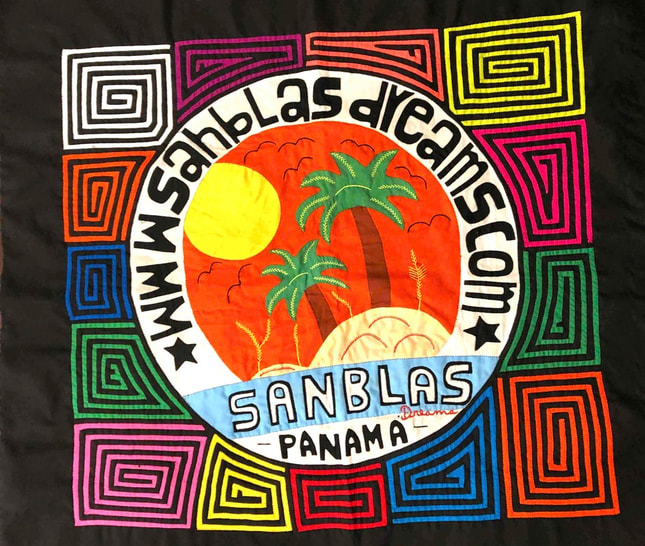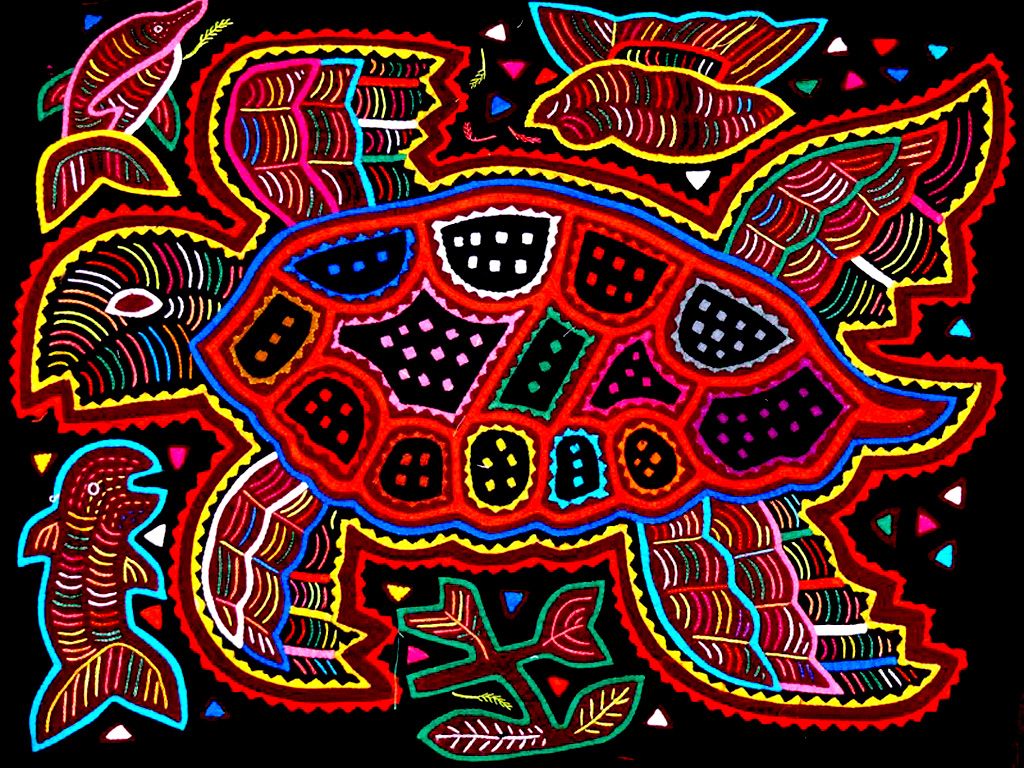|
At first glance, the dress of the Guna women appears to be a "primitive" costume of vibrant color, pattern and intricate design. The focal point of their dress is the "Mola" a blouse constructed around two elaborate panels of finely stitched fabric. "Mola" which means "blouse" in the Guna language, is now also used to refer to the panels the blouse is made of. During the early years of European presence in the New World, references spoke of Guna women as converting their lower body in a skirt-like garment made of homespun fabric while the rest of their bodies were painted in colorful designs. These designs were representations of their culture. Geometric in design, they often formed labyrinths that included people, flora, and fauna. The labyrinth embodied the story of the Guna people, representing the paths of their lives as a symbol of connectivity to mark their beginnings and endings. Over the next few hundred years, the influence of missionaries and the increasing availability of trade goods saw the mola evolve from body painting to fabric painting and, eventually, to stitching their traditional designs in layers of colorful cloth. It was not more than 150 years ago that "molas" similar to those of today began to appear as access to fabric, needles, thimbles, thread, and scissors increased. The Panels were much larger, designs less complex, and stitching less fine, yet they repeated their traditional shapes and designs. Thus, the "mola" became folk art and the cultural expression of Guna women. "Mola" designs themselves, like the entire textile medium, have also evolved over time. By the early 20th century, the classic geometric representations of their world had begun to evolve into more realistic renditions of flora and fauna, of life's celebrations and events. By the 1930's and 1940's politics, western religions, trademarks, and industrial icons began to appear. By the end of the century, history had been recorded - aviation, space travel, moon missions, moon walks, sports, and celebrities often intertwined with the underlying and very traditional geometrics and labyrinths. "Molas" are made of two or more layers of colored cloth with the complexity of design affected by the number of layers. The quality of a "Mola" is general judged by the number of layers, the quality of stitching, the proportions of cutwork, finishing details, the art, use of color, and balance of the design.
Once design and colors are decided upon, the layers are basted together and outlines are sketched onto the top layer as a guide: the most common top colors are black and red. The process is a form of cut work appliqué with each layer cut and stitched to the reveal the color of the layer underneath. Additional color is achieved by slipping leftover scraps of colored fabric between the layers and, as the work progresses, the imagines of the final picture begin to appear. The "Mola" is ready once the finishing touches of any standard appliqué or embroidery are added. "Molas" are traditionally made in pairs because they are produced as part of the blouse. While the pairs are always very similar, they are never identical; trade "Molas", produced specifically to be sold to tourists or other enthusiasts, can be found in singles. A dominant aspect of the "Mola" as folk art is that it is not only a unique piece of art, but also a daily part of Guna life and an expression of ethnic identity. The Guna women use their needlework tho showcase their creativity and talent, and contribute to their community's economy. The "mola" is not part of a primitive costume. Instead, it is a unique, complex, and intrinsically sophisticated creation that tells the story of the Guna people and an enduring culture that is unwilling to let go of tradition, yet flexible enough to survive in the modern world. What are you waiting for to come and discover the Guna Molas? Search on our San Blas Panama Map and choose your Island.
0 Comments
Leave a Reply. |
AuthorAll people can be part of this blog, tell us about your experience in San Blas Islands or some tips for traveling to Panama. Archives
February 2024
Categories |
- Home
- SAN BLAS TOURS
- PANAMA TRAVEL | OTHER TOURS
- Boat Panama/Colombia/Panama
- MULTI-DAY TOURS
- PRIVATE TRANSFERS
- CONTACT
- ABOUT US
- FAQ
- Home
- San Blas Tours
- DESCUBRE PANAMÁ | OTROS TOURS
- MULTI-DAY TOURS
- Bote Panama/Colombia/Panama
- SERVICIO DE TRANSPORTE
- Contacto
- SOBRE NOSOTROS
- FAQ
- Home
- SAN BLAS TOURS
- SCOPRI PANAMÁ | ALTRI TOURS
- MULTI-DAY TOURS
- Barca Panama/Colombia/Panama
- SERVIZIO DI TRASPORTO
- Contatti
- CHI SIAMO
- COME PRENOTARE UN TOUR?
- FAQ
SITE MAP:
BEFORE BOOKING A TOUR TO SAN BLAS
|
LA CASA DE PAPEL 3 | SAN BLAS
|
San Blas dreams
|
MAPA DEL SITIO WEB:
ANTES DE RESERVAR UN TOUR A SAN BLAS
|
NUESTRO BLOG
|
SAN BLAS DREAMS
|
MAPPA DEL SITO:
prima di prenotare un tour alle san blas
|
|
SAN BLAS DREAMS
|


 RSS Feed
RSS Feed








